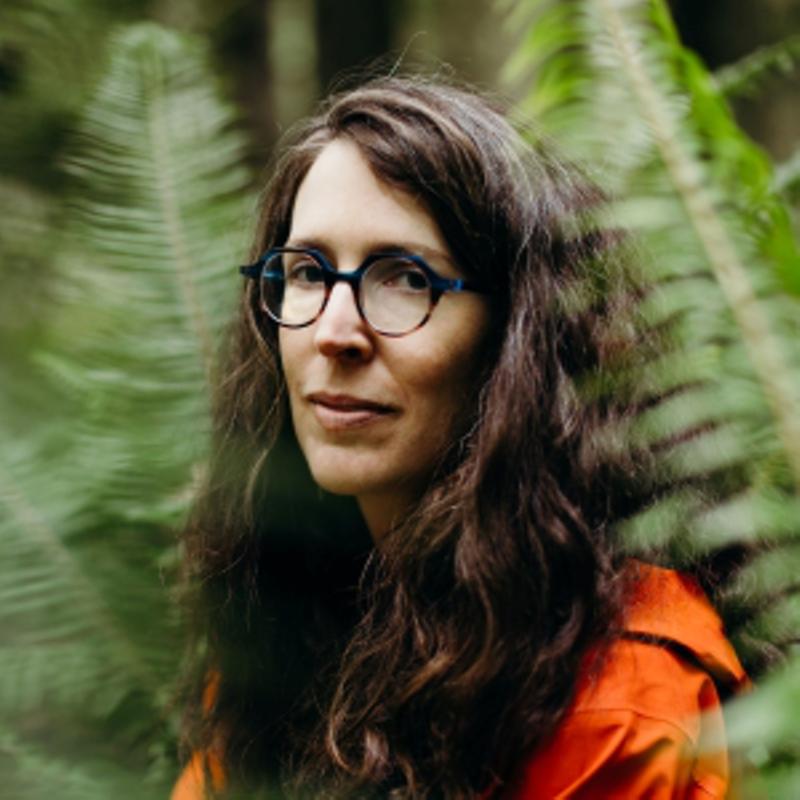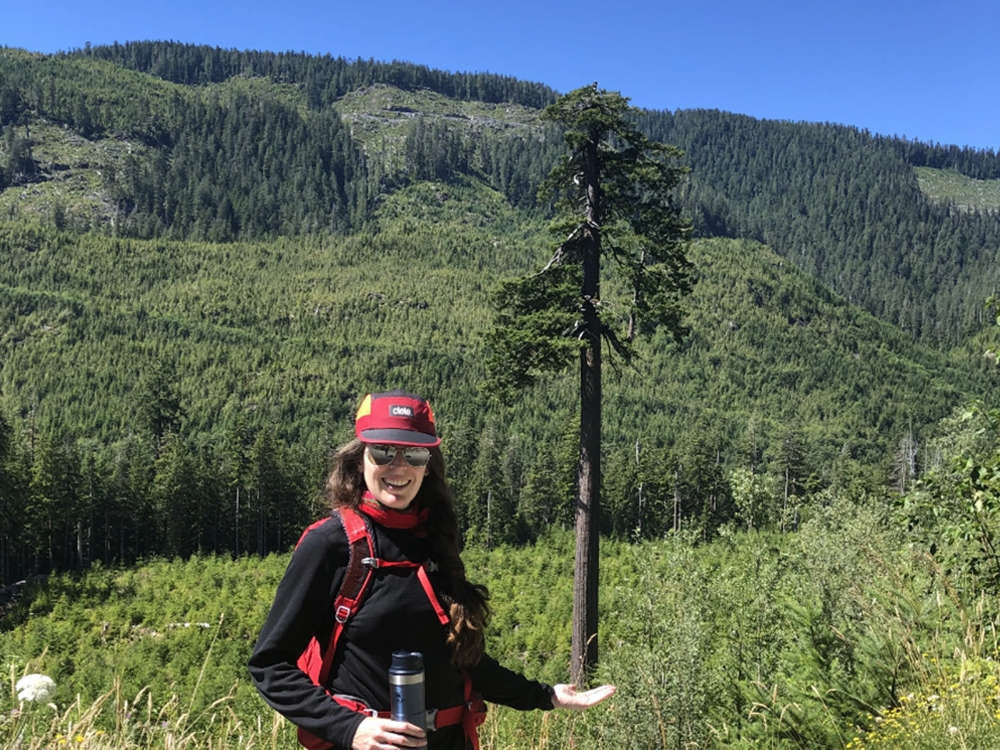[Editor’s note: In 'Tracking Giants: Big Trees, Tiny Triumphs and Misadventures in the Forest', award-winning book editor Amanda Lewis sets off to visit all of B.C.’s 'Champion' big trees — that is, the largest examples of their species documented in the BC BigTree Registry. In part, the project is a way to reconnect with her surroundings; when it becomes clear that her checklist approach to visiting the forest is replicating some of the very habits that drove her outside in the first place, she realizes she needs to reframe her search, embracing the nuances of the journey and taking the challenge as a way to deepen community. In this excerpt, she joins a new friend in search of B.C.’s Champion yew, located in North Vancouver.]
“Hiking Capilano River Park with Stephen Hui and heading into the Cap watershed to find large Pacific yew. Safety,” I texted my sister Jenny, the Official Safety Checker for all my hikes, early one morning.
“Safety,” Jenny texted back.
I met Stephen at East Café, on the corner of Nanaimo and Hastings in East Van (good jazz, great sausage rolls). I’d invited him over Twitter after reading his book 105 Hikes In and Around Southwestern British Columbia, a followup to David and Mary Macaree’s classic hiking guide.
We drove to Capilano River Regional Park in North Van and parked at the salmon hatchery. After checking out the spawning chinook and the Cleveland Dam, which contains the water from the Capilano watershed that supplies Vancouver with fresh drinking water, we headed into the woods, Stephen leading the way.
The University of British Columbia’s BigTree Registry lists the Champion Pacific yew as 23.5 metres in height (about the height of a seven-storey building) with a 0.91-metre diameter at breast height and 10.4-metre crown — huge for a yew, indicating a great age for this usually small and slow-growing tree.
Yews generally reach a height of 10 to 15 metres but can grow taller when left undisturbed in sheltered areas, like gullies, and in protected areas, like closed watersheds. Pacific yew, also known as western yew, generally grows in the shelter of Douglas firs, hemlocks and cedars, its long, somewhat spindly branches sweeping the ground and seeming to nod compared to the surrounding upright conifers. Yews tend to lose their heartwood and cease growing as they reach old age; they reproduce through seed dispersal and layering, as western red cedar and vine maple do.
Their cones hold one seed each, and they don’t look like typical conifer cones: each seed is surrounded by a red aril, similar to a berry and open on one end. Their needles grow in a flattened spiral, and the outer bark is scaly and thin, red or purple, with a rosy inner bark. The vascular cambium and bark used to be harvested for a type of chemotherapy drug called paclitaxel, but drug manufacturers now use a semisynthetic version of cultivated Pacific yew bark to make a similar drug, called Taxol, instead.
The forest ecologist Suzanne Simard recounts in her memoir, Finding the Mother Tree, that Indigenous peoples had long known of the medicinal quality of the yew. “When the anticancer qualities of the yew were brought to the attention of the modern pharmaceutical industry,” Simard writes, “there was a bounty on the trees. I’d find the small yews — their branches as long as their stems — stripped naked of their bark, looking like crosses, specters of maltreatment.”
Indigenous peoples also have multiple uses for the Pacific yew’s strong wood, from paddles to digging sticks to bows; it’s similar to the English yew, which was used to make longbows. Yews are regarded as sacred in numerous cultures and are common in churchyards in Ireland and England.
Jim Robbins, author of The Man Who Planted Trees — about David Milarch, who co-founded the Archangel Ancient Tree Archive — argues that their purpose was for conversion. “Churches and monasteries throughout Ireland were often built on sites sacred to the pagans, so that people who came to visit the sacred yew might also visit the church and be converted,” he writes.
The true reason, however, might have been more economical: planting a toxic yew was a less expensive proposition for the church than building a fence to keep sheep out.
I turned to Randy Stoltmann’s hiking guide for more information on the old-growth trees in the Capilano River area, including a map of where to find them.
“What is that, a library book?” Stephen scoffed. “Just buy the thing.”
Stephen and I set the GPS with the co-ordinates for the Pacific yew and headed into the woods. We soon emerged in the swanky residential area of the British Properties in West Van and hiked uphill on the roads for about 15 minutes, passing multimillion-dollar homes.
“Have you checked out the Capilano Suspension Bridge yet?” Stephen asked. This long swinging bridge is suspended 230 feet above the Capilano River, and the surrounding park has lots of old growth.
“No! That’s a good idea,” I said. “I haven’t been there since I was a kid.”
“You should go,” he said. “It’s like Disneyland for trees.”
The irony of looking for a Pacific yew is that yews tend to pop up when you’re not looking for them. These short slender trees blend in and thrive in the shade of bigger trees but sometimes give themselves away with a flash of blue-red bark. We looped back into the forest, coming to a water tower.
The Champion Pacific yew is in the Capilano watershed, one of the few closed watersheds in North America, and entirely off-limits to the public. But we figured it wouldn’t hurt anyone if we walked, pure of heart and with responsible faces, for half a mile in the watershed to see a tree, right? We didn’t plan on the barbed-wire fence enclosing it. After skirting a section of the perimeter, we found a way to get in but decided it wasn’t worth being “prosecuted” for trying to find the yew. While trespassing is sometimes worth the risk, it could also result in official charges that I didn’t want shadowing me on this big-tree journey.
Not wanting to waste the sunny day, we set out on a section of the Baden Powell trail, a long connector route along lower Hollyburn Mountain, which Stephen hadn’t hiked yet. Near the Brothers Creek forestry road, we saw the candelabra fir described in Stoltmann’s first hiking guide: a dead Douglas fir more than 60 metres tall, so named because of the candelabra-shaped leaders at its top.
This area was logged in the 1920s, and some old-growth firs were left because their tops were gnarly, which can indicate rot, or because they had twisted trunks, like the candelabra fir.
Along the trail, we found rusted buckets and spikes from the logging railway. Logging outfits would first make skid roads and then miniature railways to transport logs out of the woods. Another way to move lumber was through flumes, long troughs with rushing water that would carry logs, shingles, even daring loggers who wanted a quick ride into town on a Friday night. These flumes inspired the Flume at Playland at the PNE, in which passengers sit in a log-shaped car and splash down in a trough of water at the bottom of a gentle roller coaster.
Back at the parking lot, we followed Stoltmann’s map to find three Pacific yews near the garbage cans. You know what they say: location, location, location. The largest of these three yews, leaning at a rakish angle above the path, is possibly more than 200 years old; it is growing needles on just its top half, which speaks to its age.
Since we couldn’t visit our quarry, and there were no photos of it on the registry, I used these present examples to imagine the Champion yew, growing at an angle on a rocky hillside in the watershed. In my mind’s eye, I saw dirt loosely packed around the yew and moss clinging to the bark that hadn’t flaked away to reveal the surprisingly smooth inner bark. Bright red arils glistened like ornaments amid the green needles, and birds flitted in to eat the pulp, leaving the delicate branches to sway when they alighted. The forest was not silent.
We headed back across the Burrard Inlet, and I dropped Stephen off, making plans for a future hike. I hoped we could return to see the Hollyburn fir, a 1,100-year-old Doug fir just a bit west from where we’d been hiking. A tree for another day.
“Back in East Van,” I texted Jenny.
“Safety,” she texted back.
Adapted with permission of the publisher from the book 'Tracking Giants: Big Trees, Tiny Triumphs and Misadventures in the Forest,' written by Amanda Lewis and published by Greystone Books in May 2023. ![]()
Read more: Rights + Justice, Environment
















Tyee Commenting Guidelines
Comments that violate guidelines risk being deleted, and violations may result in a temporary or permanent user ban. Maintain the spirit of good conversation to stay in the discussion and be patient with moderators. Comments are reviewed regularly but not in real time.
Do:
Do not: